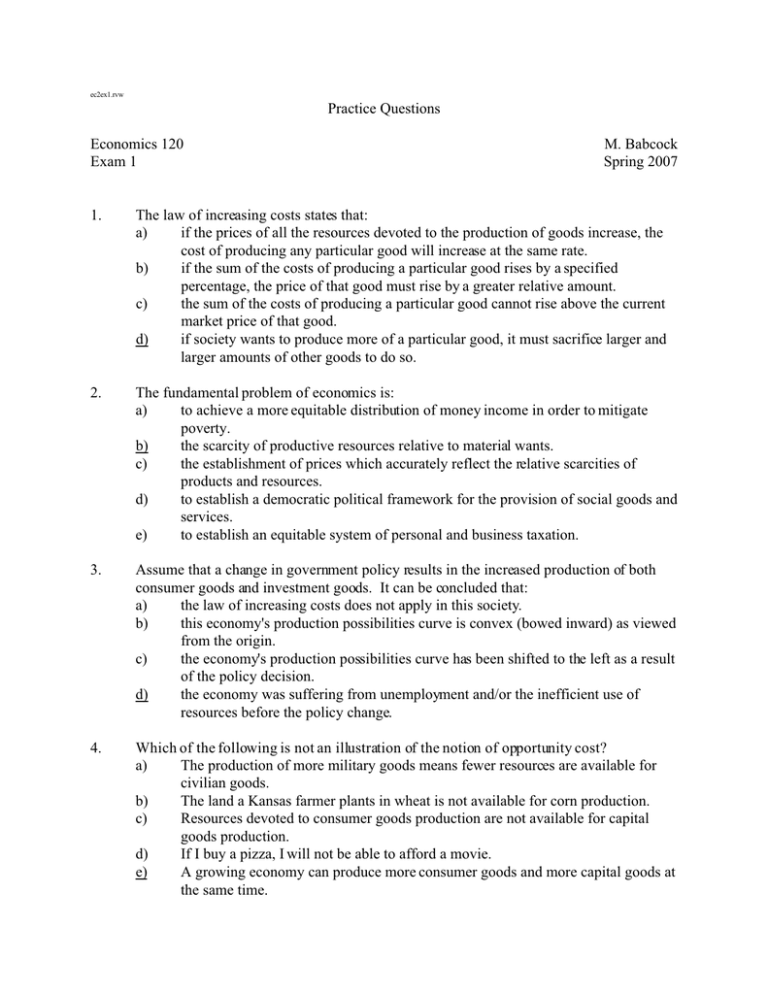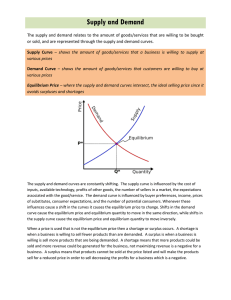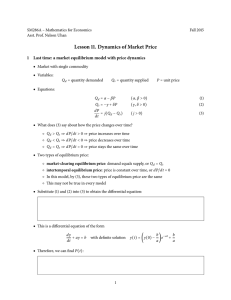Practice Questions Economics 120 M. Babcock Exam 1
advertisement

ec2ex1.rvw Practice Questions Economics 120 Exam 1 M. Babcock Spring 2007 1. The law of increasing costs states that: a) if the prices of all the resources devoted to the production of goods increase, the cost of producing any particular good will increase at the same rate. b) if the sum of the costs of producing a particular good rises by a specified percentage, the price of that good must rise by a greater relative amount. c) the sum of the costs of producing a particular good cannot rise above the current market price of that good. d) if society wants to produce more of a particular good, it must sacrifice larger and larger amounts of other goods to do so. 2. The fundamental problem of economics is: a) to achieve a more equitable distribution of money income in order to mitigate poverty. b) the scarcity of productive resources relative to material wants. c) the establishment of prices which accurately reflect the relative scarcities of products and resources. d) to establish a democratic political framework for the provision of social goods and services. e) to establish an equitable system of personal and business taxation. 3. Assume that a change in government policy results in the increased production of both consumer goods and investment goods. It can be concluded that: a) the law of increasing costs does not apply in this society. b) this economy's production possibilities curve is convex (bowed inward) as viewed from the origin. c) the economy's production possibilities curve has been shifted to the left as a result of the policy decision. d) the economy was suffering from unemployment and/or the inefficient use of resources before the policy change. 4. Which of the following is not an illustration of the notion of opportunity cost? a) The production of more military goods means fewer resources are available for civilian goods. b) The land a Kansas farmer plants in wheat is not available for corn production. c) Resources devoted to consumer goods production are not available for capital goods production. d) If I buy a pizza, I will not be able to afford a movie. e) A growing economy can produce more consumer goods and more capital goods at the same time. 5. Which of the following will tend to shift the production possibilities curve to the right? a) an increase in the unemployment rate from 6 to 8 percent b) a decline in the efficiency with which the present labor force is allocated c) a decrease in the unemployment rate from 8 to 6 percent d) a technological advance which allows farmers to produce more output from given inputs e) none of the above 6. Which of the following statements is incorrect? a) If supply declines and demand remains constant, equilibrium price will rise. b) If demand decreases and supply increases, equilibrium price will rise. c) If supply increases and demand decreases, equilibrium price will fall. d) If demand increases and supply decreases, equilibrium price will rise. 7. In which of the following instances will the effect upon equilibrium price be indeterminant, that is, dependent upon the magnitude of the given shifts in supply and demand? a) demand rises and supply is constant b) supply rises and demand falls c) demand rises and supply falls d) supply falls and demand remains constant e) demand rises and supply rises 8. If the supply and demand curves for a product both decrease, we can say that equilibrium: a) b) c) d) 9. quantity and equilibrium price must both decline. quantity must decline, but equilibrium price may either rise, fall, or remain unchanged. price must fall, but equilibrium quantity may either rise, fall, or remain unchanged. quantity must fall and equilibrium price must rise. If the supply of a product decreases and the demand for that product simultaneously increases, we can conclude that equilibrium: a) quantity must decrease, but equilibrium price may either rise, fall, or remain unchanged. b) price and equilibrium quantity must both decline. c) price and equilibrium quantity must both increase. d) price must rise and equilibrium quantity must fall. e) price must rise, but equilibrium quantity may either rise, fall, or remain unchanged. 10. Assuming competitive markets with typical supply and demand curves, which of the following statements is correct? a) An increase in demand with no change in supply will result in a decline in sales. b) An increase in demand with no change in supply will result in an increase in sales. c) d) e) An increase in supply with no change in demand will result in a decline in sales. An increase in supply with no change in demand will result in an increase in price. An increase in supply with a decrease in demand will result in an increase in price. 11. In moving along a stable demand curve which of the following is NOT held constant? a) the prices of substitute goods b) the prices of complementary goods c) consumer incomes d) price expectations e) the price of the product for which the demand curve is relevant 12. In moving along a stable supply curve which of the following is NOT held constant? a) the prices of the resources used in producing this good b) the price of the product for which the supply curve is relevant c) techniques used in producing this product d) expectations about the future price of the product e) the number of firms producing this good 13. If products A and B are complements and the price of B decreases: a) the demand for A will decline and the demand for B will increase. b) the demand for A will increase and the amount of B demanded will increase. c) the amount of B purchased will increase, but the demand curve for A will not shift. d) the demand curves for both A and B will shift to the left. 14. If products C and D are close substitutes, an increase in the price of C will: a) shift the demand curves of both products to the left. b) shift the demand curves of both products to the right. c) shift the demand curve of D to the right. d) shift the demand curve of C to the left and the demand curve of D to the right. e) tend to cause the price of D to fall. 15. Which of the following is NOT a basic criticism of the price system? a) The price system limits individual freedom by imposing resource and product prices which buyers and sellers cannot control. b) The price system does not account for external costs and benefits. c) The price system is permissive of recession and/or inflation. d) Income inequality causes the price system to result in the production of luxuries for the rich at the expense of necessities for the poor. Resource Land Labor Capital Entrepreneurial ability Resource Prices $4 3 3 2 Possible production techniques #1 #2 #3 #4 #5 2 1 5 3 4 2 2 1 2 4 3 1 4 1 1 4 4 3 2 1 Use this figure to answer question 16 The figure illustrates all available techniques by which 20 units of a given commodity can be produced. 16. Given the indicated resource prices, the economically most efficient production technique(s) will be technique(s): a) #1. b) #2 and #4. c) #3. d) #1 and #3. e) #5. 17. From society's point of view the economic function of profits and losses is to: a) reallocate resources from less-desired to more-desired uses. b) contribute to a more equal distribution of income. c) perpetuate full employment and price level stability. d) promote the equal distribution of real assets and wealth. 18. One drawback to the proprietorship form of business organization is: a. lack of personal discretion in management. b. separation of ownership and management. c. limited access to capital. d. stifling of individual initiative. 19. Partnership is an improvement over proprietorship in that: a. partnerships are not subject to unlimited liability. b. partnerships provide a stable, unchanging form of organization. c. partnerships bring in added capital and expertise. d. decision making in a partnership is smoother and quicker. 20. The primary advantage of a corporation is: a. limited liability. b. double taxation. c. the closeness between ownership and management. d. limited access to resources. 26. The opportunity cost of moving from point A to point B is: a. 18 million doughnuts. b. 2 million doughnuts. c. 6 million glasses of milk. d. 1 million glasses of milk. 27. If an economy uses inefficient methods of production, then: a. the economy is sacrificing goods and services it could otherwise have. b. the economy will need a larger government sector. c. the economy at least will have more people employed. d. the economy will be on its production possibilities curve, but will be producing primarily one good or the other rather than nearly equal amounts of each good. 28. Increasing opportunity cost occurs because: a. workers become less productive as they work longer hours. b. resources are specialized. c. prices rise as additional output is produced. d. unemployment falls as output increases. 29. Which of the following best expresses the law of increasing costs ? a. The more units of a good someone buys, the more money that must be paid for them. b. The more units of a good someone buys, the higher will be the price charged. c. The more units of a good a country produces, the greater is the opportunity cost of an extra unit. d. The more resources a country has, the more costly will be imports. 30. How do consumers signal firms to increase production of a good? a. by bidding up the price of the good. b. by contacting government agencies. c. by writing letters to the company. d. by voting for political candidates of their choice. 31. Other things being equal, when the price of a good rises: a. quantity demanded will fall. b. quantity demanded will rise. c. demand will decrease. d. demand will increase.








